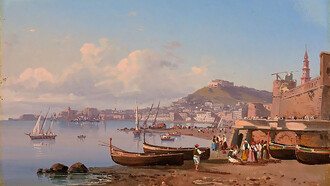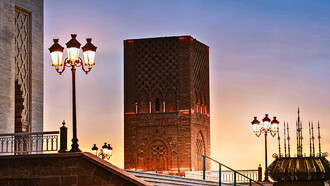In the heart of Hanoi’s Old Quarter, where motorcycles buzz past banyan trees and street vendors balance baskets of mangosteens and sticky rice, there lies a tranquil body of water with a name as poetic as its story: Hoàn Kiếm Lake or The Lake of the Returned Sword.
This shimmering lake is more than a geographical landmark. It is the symbolic heart of the city and, in many ways, of the Vietnamese nation itself. It is also the setting for one of Vietnam’s most enduring legends: a tale of magic, war, divine intervention, and the moral responsibilities of power.
The story behind Hoàn Kiếm Lake is not only rich with mythological flair, but it carries a message that still resonates: that the instruments of power do not belong to rulers, but to the people…and, perhaps, even to the gods.
The birth of the magic sword
Our story begins in the 15th century, during one of Vietnam’s darkest but also most heroic chapters. The country had been occupied by the Chinese Ming dynasty, whose brutal control stoked fierce resistance among the Vietnamese. It was during this time that a young nobleman named Lê Lợi emerged from the south as a leader of a rebellion. Born in 1385 in Thanh Hóa Province, Lê Lợi was known not only for his charisma and bravery, but for his strategic cunning and sense of mythical destiny.
According to legend, one day a humble fisherman on the Lam River hauled in something far more unusual than carp or catfish: a bar of metal that shimmered like fire. The man, puzzled, tossed it aside. A guy and his family can’t eat shimmering metal. But the next day, it turned up again in his net. This happened several times until he realized it wasn’t just any piece of metal; it was inscribed with strange markings. Soon after, it was taken to Lê Lợi, who had it forged into a sword blade.
Some time later, one of Lê Lợi’s loyal commanders discovered a hilt hidden inside a banyan tree, perfectly fitted to the blade. When the sword was united, it bore the name “Thuận Thiên” - “Will of Heaven.”
From that moment on, Lê Lợi wielded the sword in battle, and his campaign against the Ming invaders took on a miraculous quality. He became stronger, faster, and invincible in combat. His forces, once ragtag and outnumbered, began to win. Vietnamese folk songs later celebrated how Lê Lợi leapt across rivers and cut through enemy ranks with a blade that seemed to shine with otherworldly light.
In 1428, after nearly a decade of struggle, the Ming army withdrew, and Vietnam was free. Lê Lợi became emperor, founding the Later Lê dynasty, and he ushered in an era of relative peace and cultural flourishing. But the story doesn’t end there.
The turtle returns
Some time after his coronation, Emperor Lê Lợi was boating across a peaceful lake in the center of Hanoi. The war was over. The people rejoiced. The sword, however, remained at his side, just in case. Truth is, he was proud of it.
As he drifted over the lake’s glassy surface, a golden turtle emerged from the depths. This was, in fact, no ordinary turtle, but Kim Quy, the legendary Golden Turtle God, who had once served the Dragon King of the deep sea. Kim Quy approached the boat and spoke. “The Will of Heaven has been fulfilled, O King. The sword must be returned.”
Lê Lợi hesitated, but deep down inside he understood. The sword had never truly belonged to him. He raised the blade, which immediately flew from his hand and into the turtle’s mouth. Kim Quy disappeared beneath the waves, carrying the sword back to the gods. From that day on, the lake was called Hoàn Kiếm - The Lake of the Returned Sword.
Power, responsibility, and the divine mandate
What makes this legend so compelling isn’t just the magical sword or the talking turtle; it’s the moment when the hero, now king, lets go. He relinquishes his power. That, perhaps, is the real lesson at the heart of the tale.
While the legend never explicitly explains why the sword had to be returned, the implication is rich with meaning. The sword came from the heavens to serve the Vietnamese people, not to consolidate the personal power of a ruler. Its purpose was to liberate, not to dominate. Once that purpose had been fulfilled, it had to go.
The return of the sword suggests that even the most righteous rulers must eventually accept the limits of their authority. The sword, symbolic of ultimate power, was never meant to remain in the hands of one man, no matter how noble. It was a sacred tool, not a permanent possession. In returning it, Lê Lợi recognized that the gods who gave the sword to defend the people would not allow it to be used against them. It’s a surprisingly democratic message in a monarchical wrapping.
A living legend
Even today, Hoàn Kiếm Lake continues to enchant locals and visitors alike. In the center of the lake sits the small, iconic Turtle Tower (Tháp Rùa), built in the 19th century, standing like a stone whisper of the old legend. Nearby is Ngọc Sơn Temple, connected to the shore by the bright red Húc Bridge, a favorite photo spot for tourists and couples in love.
And the turtle? For years, the Vietnamese believed that one enormous soft-shell turtle, perhaps even descended from Kim Quy himself, still lived in the lake. In fact, a giant turtle was occasionally spotted, and when one died in 2016, its death was mourned as the passing of a national symbol. Locals left offerings. Some wept. It felt like the closing of a chapter, though the legend lives on.
Why this story still matters
In an age where power so often clings to itself, the story of Hoàn Kiếm Lake reminds us that true leadership involves restraint. The tools of power must be returned when their time is up. The sword is sharpest not when it cuts, but when it teaches. Vietnam’s history is filled with acts of resistance, resilience, and renewal. Lê Lợi’s tale is part of that proud tapestry, blending history with myth to inspire future generations. Whether or not a divine sword ever flashed over Vietnamese battlefields, the values behind the legend remain real.
History vs. legend: who was the real Lê Lợi?
While the legend of the magical sword and golden turtle has captured imaginations for centuries, the historical Lê Lợi was no less remarkable.
Born in 1385 in what is now Thanh Hóa Province, Lê Lợi was a wealthy landowner and respected figure before he ever picked up a sword. In 1418, he launched the Lam Sơn Uprising against the occupying Ming Chinese forces, rallying local resistance fighters into a well-organized guerrilla army. Through a mix of military genius, diplomacy, and ruthless determination, he led a successful decade-long campaign that culminated in the withdrawal of the Ming and the restoration of Vietnamese independence in 1427.
In 1428, he declared himself emperor and founded the Later Lê dynasty, which ruled (with interruptions) for over 300 years. He reorganized the government, reduced taxes, distributed land to the poor, and promoted Confucian learning and legal reform. Despite moments of harsh rule, his reign is remembered for stabilizing and strengthening the Vietnamese state.
Social meaning
The legend of Lê Lợi and the returned sword is more than a myth of divine intervention; it is a symbolic reclamation of Vietnamese agency as a self-determining culture with its own cosmic legitimacy, a sovereignty sanctified by divine forces. The Turtle God’s retrieval of the sword, at once poetic and political, signals an end to foreign rule.
The legend of Lê Lợi and the Returned Sword echoes a recurring motif in global mythology: the divine weapon bestowed in times of crisis and relinquished once justice is restored. This narrative resonates with other mythic blades: Excalibur, drawn from stone or gifted by the Lady of the Lake, affirms Arthur’s divine right to rule; Japan’s Kusanagi-no-Tsurugi, found in the tail of a slain serpent, becomes a symbol of imperial virtue; and Gram, reforged by Sigurd to slay Fafnir, embodies heroic destiny in Norse lore.
Yet Lê Lợi does not die wielding the sword, nor is it lost in battle; he returns it. The act is not tragic but transcendent, signaling the restoration of political balance. The hero becomes a great emperor not by clinging to power, but by surrendering it to the lake’s guardian spirit.














